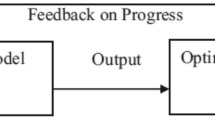Abstract
The hydrological models and simplified methods of Saint-venant equations are used extensively in hydrological modeling, in particular for the simulation of the flood routing. These models require specific and extensive data that usually makes the study of flood propagation an arduous practice. We present in this work a new model, based on a transfer function, this function is a function of parametric probability density, having a physical meaning with respect to the propagation of a hydrological signal. The inversion of the model is carried out by an optimization technique called Genetic Algorithm. It consists of evolving a population of parameters based primarily on genetic recombination operators and natural selection to find the minimum of an objective function that measures the distance between observed and simulated data. The precision of the simulations of the proposed model is compared with the response of the Hayami model and the applicability of the model is tested on a real case, the N’Fis basin river, located in the High Atlas Occidental, which presents elements that appear favorable to the study of the propagation. The results obtained are very satisfactory and the simulation of the proposed model is very close to the response of the Hayami model.
Similar content being viewed by others
References
Beven K, Binley A. 1992. The future of distributed models: model calibration and uncertainty prediction. Hydrological Processes, 6 (3): 279–298.
Cunge J A. 1969. On the subject of a flood propagation computation method (Muskingum method). Journal of Hydraulic Research, 7 (2): 205–230.
Dooge J C I. 1973. Linear Theory of Hydrologic Systems. Technical Bulletin no. 1468, USDA, Washington, DC, USA.
Franchini M, Wendling J, Obled C, Todini E. 1996. Physical interpretation and sensitivity analysis of the TOPMODEL. Journal of Hydrology, 175 (1–4): 293–338.
Hayami S. 1951. On the propagation of flood waves.I n: Bulletin–Disaster Prevention Research Institute. Kyoto University, Kyoto, Japan.
Kachroo R K. 1986. HOMS workshop on river flow forecasting, Nanjing, China. Unpublished internal report, Dep. Eng. Hydrol., University College Galway, Galway, Ireland. 149p.
Lerat J. 2009. Quels apports hydrologiques pour les modèles hydrauliques? Vers un modèle intégré de simulation des crues. Université Pierre et Marie Curie, Paris, French. (in French)
Luo Q K, Wu J F, Sun X M, Yang Y, Wu J C. 2012. Optimal design of groundwater remediation systems using a multiobjective fast harmony search algorithm. Hydrogeology Journal, 20 (8): 1 497–1 510.
McCarthy G T. 1938. The unit hydrograph and flood routing. In: Proceedings of Conference of North Atlantic Division. U.S. Army Corps of Engineers, Wahsington, DC.
Mouida A, Alaa N E. 2015. Non–domination sorting genetic algorithm II for optimization of Priestley–Taylor transpiration parameters. Annals of the University of Craiova, Mathematics and Computer Science Series, 42 (1): 3–12.
Moussa R. 1996. Analytical Hayami solution for the diffusive wave flood routing problem with lateral inflow. Hydrological Processes, 10 (9): 1 209–1 227.
Nash J E, Sutcliffe J V. 1970. River flow forecasting through conceptual models part I—a discussion of principles. Journal of Hydrology, 10 (3): 282–290.
Pinault J L, Berthier F. 2007. A methodological approach to characterize the resilience of aquatic ecosystems with application to Lake Annecy, France. Water Resources Research, 43 (1): W01418.
Poloni C, Giurgevich A, Onesti L, Pediroda V. 2000. Hybridization of a multi–objective genetic algorithm, a neural network and a classical optimizer for a complex design problem in fluid dynamics. Computer Methods in Applied Mechanics and Engineering, 1 86 (2–4): 403–420.
Author information
Authors and Affiliations
Corresponding author
Rights and permissions
About this article
Cite this article
El Alaoui El Fels, A., Alaa, N. & Bachnou, A. Use of genetic algorithm in new approach to modeling of flood routing. J. Ocean. Limnol. 37, 72–78 (2019). https://doi.org/10.1007/s00343-018-7293-4
Received:
Accepted:
Published:
Issue Date:
DOI: https://doi.org/10.1007/s00343-018-7293-4




